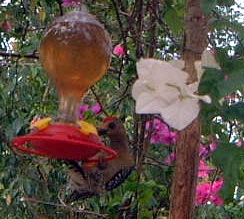|
| Query: bird | Result: 2460th of 32675 | |
Red-crowned Woodpecker (Melanerpes rubricapillus) - Wiki
| Subject: | Red-crowned Woodpecker (Melanerpes rubricapillus) - Wiki
| |

| Resolution: 244x219
File Size: 33336 Bytes
Date: 2000:01:08 03:18:34
Camera: FinePix4700 ZOOM (FUJIFILM)
F number: f/2.8
Focal Length: 940/100
Upload Date: 2007:08:17 14:04:44
|
Red-crowned Woodpecker
From Wikipedia, the free encyclopedia
[Photo] Red-crowned Woodpecker Melanerpes rubricapillus, from Tobago http://en.wikipedia.org/wiki/Tobago Date: 8 January 2000
The Red-crowned Woodpecker, Melanerpes rubricapillus, is a resident breeding bird from southwestern Costa Rica south to Colombia, Venezuela, the Guianas and Tobago.
This woodpecker occurs in forests and semi-open woodland and cultivation. It nests in a hole in a dead tree or large cactus. The clutch is two eggs, incubated by both sexes, which fledge after 31-33 days.
Adults are 20.5 cm long and weigh 48g. They have a zebra-barred black and white back and wings and a white rump. The tail is black with some white barring, and the underparts are pale buff-brown.
The male has a red crown patch and nape. The female has a buff crown and duller nape. Immature birds are duller, particularly in the red areas of the head and neck. M. r. terricolor of Tobago is larger and darker-breasted than the nominate race.
Red-crowned Woodpeckers feed on insects, but will take fruit and visit nectar feeders.
This common and conspicuous species gives a rattling krrrrrl call and both sexes drum on territory.
http://en.wikipedia.org/wiki/Red-crowned_Woodpecker
| The text in this page is based on the copyrighted Wikipedia article shown in above URL. It is used under the GNU Free Documentation License. You may redistribute it, verbatim or modified, providing that you comply with the terms of the GFDL. |
|
^o^
Animal Pictures Archive for smart phones
^o^
|
|

